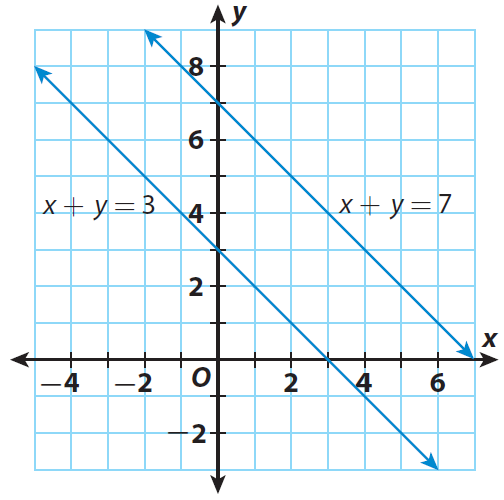SOLVING SPECIAL SYSTEMS
Subscribe to our ▶️ YouTube channel 🔴 for the latest videos, updates, and tips.
We can determine whether a system of linear equation has one solution, many solutions or no solution either by inspecting its graph or by solving it algebraically.
Example 1 :
Solve the given system of equations by graphing.
x + y = 7
4x + 4y = 12
Solution :
Step 1 :
Write the given equations in slope-intercept form.
y = mx + b
x + y = 7
y = - x + 7
(slope is -1 and y-intercept is 7)
4x + 4y = 12
Divide both sides by 4.
x + y = 3
y = - x + 3
(slope is -1 and y-intercept is 3)
Based on slope and y-intercept, we can graph the given equations.

Step 2 :
In the above graph, the lines do not intersect. They appear to be parallel and and no points in common.
Does this linear system have a solution ? Use the graph to explain.
Since the lines are parallel and they do not intersect, there is no point of intersection. So, the system has no solution.
Reflection :
1. Can you conclude that the system of linear equation has no solution without graphing ?
Yes
We have to find the slopes and y-intercepts of the given two lines. If the slopes are equal, but y-intercepts are different, the lines will be parallel. Then, the system will not have solution.
2. Can you conclude that the system of linear equation has infinitely many solutions without graphing ?
Yes
We have to find the slopes and y-intercepts of the given two lines. If the slopes are equal and y-intercepts are also equal, both the equations represent the same line. All ordered pairs on the line will make both equations true and all points on the line are points of intersection.
Then, the system will have infinitely many solutions.
Example 2 :
Determine whether the system given below has one solution, infinitely many solutions or no solution.
x + y = 3
2x + 2y = 6
Solution :
Step 1 :
Write the given equations in slope-intercept form.
y = mx + b
x + y = 3
y = - x + 3
(slope is -1 and y-intercept is 3)
2x + 2y = 6
Divide both sides by 2.
x + y = 3
y = - x + 3
(slope is -1 and y-intercept is 3)
Step 2 :
The slopes of both the equations are same and y-intercepts are also same.
So, both the equations represents the same line. All ordered pairs on the line will make both equations true and all points on the line are points of intersection.
Hence, the system has infinitely many solutions.
Example 3 :
Solve the system of linear equations by substitution.
x - y = - 2
- x + y = 4
Solution :
Step 1 :
Solve the equation - x + y = 4 for y.
- x + y = 4
Add "x" to both sides.
(-x + y) + x = (4) + x
-x + y + x = 4 + x
Simplify.
y = 4 + x
Step 2 :
Substitute y = 4 + x in the other equation.
x - y = - 2
x - (4 + x) = -2
x - 4 - x = -2
Simplify.
-4 = -2
Step 3 :
Interpret the solution.
The result (-4 = -2) is the false statement. So there is no solution for the given system.
Example 4 :
Solve the system of linear equations by elimination.
2x + y = - 2
4x + 2y = - 4
Solution :
Step 1 :
2x + y = - 2 -----(1)
4x + 2y = - 4 -----(2)
In the given system, to eliminate one of the variables, the coefficients of that variable must be same and signs must be opposite.
The coefficients of the variable x are not same in both the equations and also the variable y.
To make the coefficients of y same and signs opposite, multiply the first equation by -2.
(1) ⋅ 2 -----> (-2)(2x + y) = (-2)(-2)
-4x - 2y = 4 -----(3)
Step 2 :
Now, we can add equations (2) and (3) to eliminate the variable 2y.

Step 3 :
Interpret the solution.
The result is the statement 0 = 0, which is always true.
So the system has infinitely many solutions.
Subscribe to our ▶️ YouTube channel 🔴 for the latest videos, updates, and tips.
Kindly mail your feedback to v4formath@gmail.com
We always appreciate your feedback.
©All rights reserved. onlinemath4all.com
Recent Articles
-
10 Hard SAT Math Questions (Part - 38)
Dec 08, 25 12:12 AM
10 Hard SAT Math Questions (Part - 38) -
SAT Math Practice
Dec 05, 25 04:04 AM
SAT Math Practice - Different Topics - Concept - Formulas - Example problems with step by step explanation -
10 Hard SAT Math Questions (Part - 37)
Dec 03, 25 07:02 AM
10 Hard SAT Math Questions (Part - 37)


